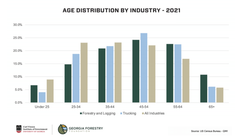In Short Supply
Addressing the LaborShortage in the GeorgiaLogging Industry
By John Casey
Fall 2022

|
Georgia Forestry Magazine is published by HL Strategy, an integrated marketing and communications firm focused on our nation's biggest challenges and opportunities. Learn more at hlstrategy.com
|
